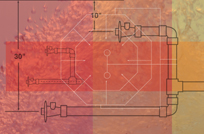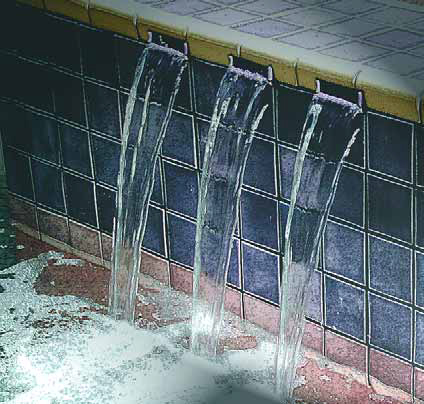water flow
Of all the concepts of hydraulic-system design, there are few that have more importance than the correlation between water flow (that is, capacity expressed as gallons per minute) and line velocity (the speed at which the water travels). As water travels through a pipe, its increase in speed (that is, its line velocity) results in an increase in resistance (expressed as feet of head) and in a reduction of end pressure, which is measured in pounds per square inch (psi). In other words, an increase in friction losses and a drop in pressure is the result of increased water velocity at a given flow. If that makes sense to you without further explanation, then you know much of what you need to know when it comes to
In most watershapes, we circulate and treat water through use of pumps and filters – and although we still don’t think about it much these days, we do so because fresh water is in precariously short supply and we can’t simply fill and dump it as we please. Yet even a perfect watershape – that is, one devoid of leaks, never subject to splash-out and never in need of backwashing – occasionally requires the addition of new water if only because evaporation will carry it away, bit by bit. In fact, there’s no way to cut Mother Nature out of her share, or to keep her from
I was out of a job in Gloucester, England, several years back when I came across a collection of wonderfully unusual sculptures that changed my life. These compositions, called Flowforms, were the work of British sculptor John Wilkes, an inspired artist who for most of his professional life has explored ways to use water’s nature and characteristics as his medium. I was immediately drawn to what I saw: I’d worked as an estate gardener before being trained as a sculptor at the St. Martin School of Art in London and had always had an interest in natural forms and all sorts of experimental media. I had also spent a good part of
Not to diminish the painted ponies of The Wizard of Oz, but Steve Mann’s hydraulophones are horses of a different color. These watershapes come in all sorts of shapes and sizes, from landmark centerpieces that have the sculptural grandeur of pipe organs all the way down to water-flutes that resemble brightly colored tadpoles. What’s most remarkable about these devices isn’t just their structural and artistic variety or the ways they look as visual art: It’s the sounds they make. At first, the natural comparison is to a pipe organ, but as you listen, a variety of shadings and other sonic reverberations emerge, slip and slide around you. What’s more, hydraulophones invite people to insert their fingers into the jetting water to shape the sound and squeeze out the shape of each note, and a variety of sonic textures are possible depending upon
Working successfully with hydraulic systems requires two things: Understanding the definitions of the basic factors involved in hydraulic calculations and seeing how those values relate to and influence each other in the real world. The last installment in this series of articles focused on the relationship between flow and velocity with respect to water. The related concept we’ll explore this time takes our understanding of that key relationship a step farther by exploring a specific pair of additional relations summarized by
As much I enjoy seeing my own projects come to fruition, there's something wonderful in seeing watershapers I know achieve great results in their work. I admire and encourage the effort, especially when the outstanding outcomes are the result of a professional's concentrated efforts to improve his or her own skills. This is one of the reasons I teach: I take great satisfaction in sharing my techniques, sensibilities and the conviction that what I do is special, a true form of art.Sometimes I speak with former
At its most basic, public art creates spaces in which people experience art without paying hard-earned dollars to own it or going to a museum or gallery to see it. Public art is also about giving everyone within eyeshot new types of experiences amid their daily routines. Perhaps it's an object they'll pass on the way to the subway or an environment they'll spot out of the corner of an eye as they drive to the grocery store. Maybe it's a place where people gather to eat lunch or a landmark for arranging meetings with friends. Whether it's familiar to the viewer or sneaks up unexpectedly, the work becomes
The avant-garde composer John Cage once said, “Art exists to make us aware of the very life we’re living.” I’ve always loved that statement because, as someone working to create works of art, the experiences of my own life have naturally been transferred into the way I’ve chosen to express myself – and, I hope, have enabled me to succeed in bringing other people to an awareness of experiences in their own lives. For me, water is the key in these transferences: Even though I’m probably more often described as a sculptor of natural stone rather than as a watershaper, the dialogues I have with the materials I use and with those who observe the outcomes have always begun with the way I work with water. I grew up in the Midwest on the banks of the Mississippi. As a child, I lingered on the untamed shores of the creeks, streams and rivers that laced across an otherwise developed and thoroughly mechanized landscape. I would read or draw, stroll idly along a stream, or spend hours building a raft or dam. This was well before I’d begun to think about my relationship with water in any sort of artistic way, but there’s no question that those experiences remain at the heart of my passion for working within this
Most people know Maya Lin for her bold design of the Vietnam Veterans Memorial in Washington, but watershapers in particular should become familiar with a range of her other works as well. For nearly 15 years, reports William Hobbs, his company has been involved in producing intricate water effects for the famous artist, whose works draw fascinating connections between observers and the mysteries of time and nature. The marriage of water and art can be extremely powerful and evocative, especially in the hands of a great designer. One who has taken the use of water to sublime and fantastic levels is Maya Lin, the artist who rose to prominence as a





















